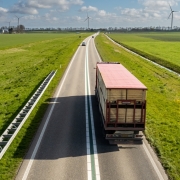
It’s a fact that the trucking industry keeps the economy moving. Every day, drivers haul essential goods across the country, connecting farms, factories, stores, and homes.
However, it’s also a fact that the same industry that keeps shelves stocked also contributes significantly to greenhouse gas emissions. In recent years, both fleets and individual drivers have been looking for ways to make trucking more sustainable.
Reducing your carbon footprint as a driver doesn’t always require major changes or expensive upgrades. Many small choices made daily can add up to meaningful results. From adjusting your driving habits to taking better care of your truck, here are 9 practical steps every truck driver can take to help the environment while staying efficient and safe on the road.
Prioritize Fuel Efficiency
Fuel efficiency is one of the most important factors in reducing emissions. Since most emissions come from fuel combustion, improving miles per gallon directly lowers your carbon footprint.
You can start by maintaining steady speeds and minimizing unnecessary idling. Cruise control can help you keep a consistent pace on highways, while gentle acceleration and braking reduce wasted fuel. Even small adjustments, such as easing up on the throttle when approaching traffic or hills, can improve efficiency over time.
You can also use route-planning tools and apps that avoid heavy traffic or steep grades. These can help save fuel while also reducing wear and tear on your vehicle.
Keep Up with Preventive Maintenance
A well-maintained truck runs cleaner and more efficiently. Simple tasks like checking tire pressure, replacing air filters, and scheduling regular engine tune-ups make a real difference in performance.
Low tire pressure, for example, can reduce fuel economy by up to 3%. Dirty air filters restrict airflow, causing the engine to burn more fuel. Even ensuring that your truck’s alignment and oil levels are correct can prevent wasted energy.
When possible, it also helps to choose low-viscosity synthetic oils and high-efficiency filters. These improve lubrication and engine performance, which reduces friction and energy loss.
Minimize Idling Time
Idling is one of the biggest sources of unnecessary fuel use. According to the U.S. Department of Energy, long-haul trucks can waste more than 1,500 gallons of fuel per year through idling alone.
Whenever possible, turn off your engine during extended stops. Many truck stops and rest areas now offer electrified parking spaces or idle-reduction technologies that allow drivers to power cab systems without running the engine. Auxiliary power units (APUs) are another option, providing heating, cooling, and electrical power using far less fuel.
Even small reductions in idling time each day can lead to large annual fuel savings and lower emissions.
Adopt Smart Driving Habits
Efficient driving goes beyond just watching the fuel gauge. Smooth driving reduces mechanical stress on your truck and improves overall sustainability.
Try to avoid rapid acceleration and harsh braking, as these increase fuel consumption and wear out tires and brake components faster. Plan your moves ahead of time by trying to anticipate traffic flow, lights, and turns to keep momentum steady and reduce the need for sudden stops.
If your truck is equipped with telematics, be sure to review the data to see where you can improve. Many fleets use these systems to track idling time, RPMs, and fuel use, helping drivers identify areas for better performance.
Reduce Weight and Drag
The heavier your load and the greater your truck’s drag, the more fuel your engine needs to keep moving. While you can’t always control cargo weight, there are steps you can take to make your vehicle more aerodynamic.
Remove unnecessary items from your cab and ensure that external attachments like toolboxes or spare parts are properly stored. Close trailer gaps with fairings or side skirts if available, as they can improve airflow and boost MPG.
Even keeping windows closed at highway speeds helps reduce drag. Small adjustments like these can make a noticeable difference in fuel use over long distances.
Choose Eco-Friendly Products and Fuels
If you have the option, consider using biodiesel blends or renewable diesel. These fuels are made from plant oils or waste fats and can significantly reduce lifecycle emissions.
You can also choose eco-friendly products in your day-to-day routine. Refillable water bottles, reusable utensils, and biodegradable cleaning supplies reduce waste. Even properly disposing of used oil, filters, and tires helps prevent environmental harm.
More carriers are also adopting electric or hybrid vehicles, especially for regional and short-haul routes. If your company uses these, consider taking time to learn the systems and how to operate them efficiently.
Support Sustainable Carriers and Practices
Many trucking companies are setting sustainability goals, from lowering emissions to improving recycling and energy efficiency in their facilities. Drivers can play a key role in supporting these efforts.
Be sure to follow company sustainability policies, such as fuel-saving targets or recycling initiatives. You should also offer feedback or ideas to improve efficiency on the road, since drivers often notice opportunities that managers may overlook. By staying informed and proactive, you contribute to broader industry change.
Plan Ahead and Combine Trips
Trip planning doesn’t just save time and stress. It also reduces the number of miles driven unnecessarily. Before starting your day, map out the most efficient route that accounts for delivery times, rest breaks, and fuel stops.
If you’re an owner-operator, look for opportunities to combine loads or backhauls to prevent empty miles. Technology tools can help match available freight with your route to maximize each trip’s productivity and sustainability.
Educate and Inspire Others
Finally, one of the best things drivers can do for sustainability is to spread awareness. You can do this by sharing fuel-saving tips with new drivers, discussing idle-reduction benefits, or by posting about eco-friendly trucking habits online. The more the message circulates, the more likely it is that others will adopt greener habits.
Small changes made by thousands of drivers can have a major collective impact. As the industry continues to move toward lower emissions and cleaner technology, drivers will remain central to that progress.
Wondering about other ways to stay ahead of the curve in the transportation industry in 2025? Be sure to check out more posts on our blog and connect with us on social media!






